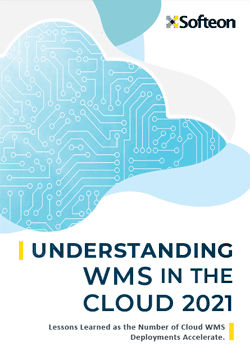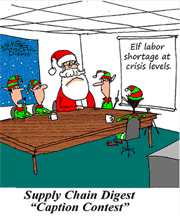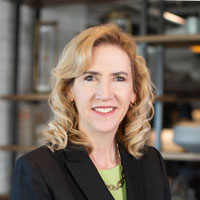The Top Supply Chain Stories by Month 2021
It was truly a crazy year first half year in supply chain - from shortages of everything to a ship stuck in the Suex Canal.
Here, my choices for the top supply chain stories by month in the first half of the 2021. We are space constained in this column and had to make some cuts, but will have a longer list in next week's OnTarget newsletter.
Here we go:
| GILMORE SAYS: |
WHAT DO YOU SAY?'
There were many other important stories last year - what did I leave out?
Send us your
Feedback here
|
January
In surprising news, Rick Blasgen, CEO of the Council of Supply Chain Management Professionals (CSCM), announces his plan to retire in March. Blasgen, a former supply chain executive at Conagra and others, had run CSCMP since 2005. The CSCMP board of directors names Mark Baxa, a previous chairman of the CSCMP board and current CEO of FerniaCreek Global Supply Chain Consulting Group, as interim CEO. There is surely some back story here, but I never pursued it.
UPS announces its plan to exit its LTL business with sale of its UPS Freight unit to Canadian logistics firm TFI International for about $800 million, a seemingly low number that was just one fourth of UPS Freight's estimated 2020 revenue of about $3.15 billion. The move allows UPS to shed itself of a low growth business and concentrate its investments in the parcel market while giving TFI an immediate strong presence in the US.
February
Sports gear maker Under Armour says it will stop selling through as many as 3000 current retail customers by the end of 2021, as the company puts more focus on its direct to consumer business. As such, Under Armour is mirroring rival Nike's strategy, as Nike a couple of years ago announced plans to cut it retail channels globally from some 36,000 to a few dozen. Last June, Nike also announced a Consumer Direct Acceleration program - the term says it all. Under Armour said the retail channel reductions would still leave it with 10,000 retailers by the end of 2022, but the direction is clear.
March
Canadian Pacific Railway and Kansas City Southern Railway announce they will merge as part of a $25 billion deal that will create a rail freight network that spans Canada to Mexico. Or so it seems. Not long after, Canadian National announces a larger $33 billion offer. There is some drama, but Canadian Pacific ultimately prevails after regulatory concerns over the deal with CN.
In a crazy mishap, a large container ship from Japan's Evergreen line gets turned almost sideways entering the Suez Canal from the Red Sea and becomes stuck. About a quarter mile long (400 meters) and weighing in at 200,000 tons, the ship's sheer size overwhelms efforts to dig it out. The ship remains stuck for six days, with 400 cargo vessels waiting at sea for the blockage to end. Canal owner Egypt holds the Even Given and its 25 crew members until just last week, due to wrangling over compensation for the accident. It took a $550 million payment in the end from Evergreen and its insurers to free the ship.
April
In an intensely watched action, workers at an Amazon fulfillment center in Bessemer, AL overwhelmingly vote not to join the Retail, Wholesale and Department Store Union. By a margin of 71% to 29%, workers said no to unionization after a mail in voting period of more than a month instead of the usual in-person vote, necessitated by COVID-19 concerns - and keeps Amazon's US facilities free of unions. Many pro-labor forces expected a vote to organize that could serve as a catalyst for union votes at Amazon FCs across the country.
May
Gartner releases its top 25 supply chains list for 2021. This year Cisco Systems comes out on top for the second year in a row - sort of. I put it that way because again in 2021, Apple, Procter & Gamble, Amazon, McDonald's and Unilever were left off the formal top 25, as those five companies have been placed in a separate relatively category called "supply chain masters," a sort of supply chain hall of fame. The rest of the top 10 after Cisco were (2) Colgate-Palmolive; (3) Johnson & Johnson; (4) Schneider Electric; and (5) Nestle.
June
CSCMP and Kearney release the 2021 State of Logistics report. The headline news: what the report several years back started calling US Business Logistics Costs (USBLC) fell sharply on an absolute basis in 2020, down 4.0% to $1.55 trillion. With a smaller decrease in US GDP (-3.5%) than logistics cost fell last year, that took the relative cost of logistics as a share of GDP to 7.44%, down bit from 7.57% in 2019 - versus 8.59% in 2007.
News that FedEx Freight, the company's less-than-truckload segment, had suspended service to approximately 1400 customers due to strains in its network from rising shipment volumes. The move left many shippers in a lurch, with some complaining of little notice of the service suspension. Within a few weeks, FedEx says it had restored service to some of those dropped shippers, but not all.
July
Walmart says it will install robots from a company called Symbotic in 25 of its 42 US regional distribution centers. Wilmington, Massachusetts-based Symbotic first implemented its system in a Walmart DC in Florida in 2017 and the companies have been working to optimize the system ever since. The Symbotic system sorts, stores, retrieves, and packs freight onto pallets, Joe Metzger, executive VP of supply chain operations, Walmart US, said in a blog post. It uses advanced algorithms to store cases with a precision that speeds the intake process and increases the accuracy of freight being stored for future orders. Walmart says the rollout will take "several years" to complete.
Zebra Technologies is it will pay $240 million to acquire the 95% of mobile robot maker Fetch Robotics it doesn't already own. For Zebra, the move is another step to expand from its long time roots in data collection, focused on bar code scanners, RFID readers and mobile wireless terminals, to more of a true solutions provider. Zebra says part of the appeal of Fetch is the company's broad product line, with different robots for different types of warehouse applications.
August
Amazon officially opens its massive new Prime Air hub at the Cincinnati airport. The facility will have 3 million square feet of logistics space across seven planned buildings. Notable among all that space is an 800,000-square-foot sortation building equipped with robots and many miles of interlinked conveyors. The facility will serve as Amazon's largest air hub, and is expected to handle as many as 200 cargo flights per day. It will operate across an amazing 600 acres, and soon employ 2000 people. It will include an expansive new tarmac with parking for about 100 planes. When the hub was announced a few years back, Amazon said it would take $1.5 million to develop.
The California Trucking Association appeals to Supreme Court as it promised when it lost a full Appeals Court decision in June on the legality of California's so-called AB-5 legislation. That law would in practice eliminate contract truck drivers in the state by defining an onerous to see if a worker qualifies as an independent. If the Court takes the case, the CTA would seem to have a strong argument, given a 1994 US law creating federal pre-emption of transportation law, passed to avoid the impossibility of truckers needing to comply with individual rules state by state. The court has not decided if it will take the case.
September
FedEx says in recently ended fiscal quarter it incurred $450 million extra costs due to the on-going labor shortage. The company said the lack of labor led to increased overtime, higher wages to attract workers and extra spending on expedited transportation. The company cited the specific example of a sorting hub in Portland, OR, that had 65% of the workers needed to handle the normal number of packages that go through that facility. FedEx also said it is raising pay levels and paying premiums for weekend shifts to try to attract more workers
October
The Labor Department reports that the US consumer price index (CPI) rose 5.4% in September versus the same month a year ago. The year-over-year gain in prices was the highest for any month since 1991, as supply chain driven-inflation threatens the overall economy, and continues in the remaining months of the year.
 The two largest so-called regional parcel carriers announced they are combining in deal that will give the merged company a network that can deliver to most of the US. Virginia-based LaserShip agreed to buy OnTrac Logistics, out of Arizona, for some $1.3 billion. LaserShip a short time later announces Mark Holifield, chief supply chain officer at Home Depot, will become its CEO. The two largest so-called regional parcel carriers announced they are combining in deal that will give the merged company a network that can deliver to most of the US. Virginia-based LaserShip agreed to buy OnTrac Logistics, out of Arizona, for some $1.3 billion. LaserShip a short time later announces Mark Holifield, chief supply chain officer at Home Depot, will become its CEO.
November
President Biden the long awaited "Infrastructure Bill" into law with generally bi-partisan support. The bill will provide $1.2 trillion in spending across many areas, but really a smaller $550 million over 5 years in funds above what has already been committed. Roads, bridges, and other "major projects" get $110 billion, while port infrastructure receives $17 billion. Will it really have an impact, and is it really "paid for?" Who knows.
A National Labor Relations Board (NLRB) regional office orders Amazon to hold another union election at one of its fulfillment centers in Bessemer, Ala., following Amazon's resounding victory against unionization in the first election there in March. The Retail, Wholesale and Department Store Union had appealed the results of the vote, alleging a series a labor law violation by Amazon during the process.
December
Reports that Amazon is taking direct control of a number of global logistics service in the face of soaring costs and delays in the commercial markets. Those services include chartering its own container ships, using small US ports, and contracting with Chinese manufacturers to make its own shipping containers. While Target, Walmart, Costco, Home Depot and others have also chartered container ships, Amazon is taking it to a whole new level, moving some 10,000 containers per month, filled with goods from small- and medium-sized Chinese exporters, and also working with the ship owners to modify bulk cargo ships built to move commodities to handle containers cargo instead. Internally, Amazon calls this project "Dragon Boat."
The number of ships in the water awaiting a berth at the ports of Los Angeles and Long Beach reaches a record 111, as shipping delays continue to grow. Prior to the pandemic, the ports' highest record had been 17 ships waiting to anchor. Opening some terminals for 24 x 7 container moves, proves a false hope, as for a variety of reasons there are few takers. The ports also vastly spread out waiting ships in the water over fears of winter winds and tides causing collisions.
So there you go. There were many other important stories so far this year - what did I leave out?
Any other top supply chain stories of 2021? Let us know your thoughts at the Feedback section below.
|









 The two largest so-called regional parcel carriers announced they are combining in deal that will give the merged company a network that can deliver to most of the US. Virginia-based LaserShip agreed to buy OnTrac Logistics, out of Arizona, for some $1.3 billion. LaserShip a short time later announces Mark Holifield, chief supply chain officer at Home Depot, will become its CEO.
The two largest so-called regional parcel carriers announced they are combining in deal that will give the merged company a network that can deliver to most of the US. Virginia-based LaserShip agreed to buy OnTrac Logistics, out of Arizona, for some $1.3 billion. LaserShip a short time later announces Mark Holifield, chief supply chain officer at Home Depot, will become its CEO.


